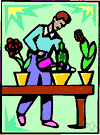phytology
Also found in: Thesaurus, Medical, Encyclopedia, Wikipedia.
phy·tol·o·gy
(fī-tŏl′ə-jē)n.
The study of plants; botany.
phy′to·log′ic (fī′tə-lŏj′ĭk), phy′to·log′i·cal (-ĭ-kəl) adj.
American Heritage® Dictionary of the English Language, Fifth Edition. Copyright © 2016 by Houghton Mifflin Harcourt Publishing Company. Published by Houghton Mifflin Harcourt Publishing Company. All rights reserved.
phytology
(faɪˈtɒlədʒɪ)n
(Botany) a rare name for botany1
phytological adj
ˌphytoˈlogically adv
phyˈtologist n
Collins English Dictionary – Complete and Unabridged, 12th Edition 2014 © HarperCollins Publishers 1991, 1994, 1998, 2000, 2003, 2006, 2007, 2009, 2011, 2014
phytology
botany.
See also: Botany-Ologies & -Isms. Copyright 2008 The Gale Group, Inc. All rights reserved.
phytology
The study of plants.
Dictionary of Unfamiliar Words by Diagram Group Copyright © 2008 by Diagram Visual Information Limited
ThesaurusAntonymsRelated WordsSynonymsLegend:
Switch to new thesaurus
| Noun | 1. |  phytology - the branch of biology that studies plants phytology - the branch of biology that studies plantsetiolation - (botany) the act of causing a plant to develop without chlorophyll by growing it without exposure to sunlight; "the etiolation of celery" biological science, biology - the science that studies living organisms mycology - the branch of botany that studies fungi and fungus-caused diseases pomology - the branch of botany that studies and cultivates fruits palaeobotany, paleobotany - the study of fossil plants pteridology - the branch of botany that studies ferns dissilience - the emergence of seeds as seed pods burst open when they are ripe aestivation, estivation - (botany) the arrangement of sepals and petals in a flower bud before it opens division - (botany) taxonomic unit of plants corresponding to a phylum venation - (botany) the arrangement of veins in a leaf vernation - (botany) the arrangement of young leaves in a leaf bud before it opens scurf - (botany) a covering that resembles scales or bran that covers some plant parts natural scientist, naturalist - a biologist knowledgeable about natural history (especially botany and zoology) kingdom Plantae, plant kingdom, Plantae - (botany) the taxonomic kingdom comprising all living or extinct plants annual - (botany) a plant that completes its entire life cycle within the space of a year biennial - (botany) a plant having a life cycle that normally takes two seasons from germination to death to complete; flowering biennials usually bloom and fruit in the second season perennial - (botany) a plant lasting for three seasons or more style - (botany) the narrow elongated part of the pistil between the ovary and the stigma germ tube - (botany) a slender tubular outgrowth from a spore in germination pollen tube - (botany) a slender tubular outgrowth from a pollen grain when deposited on the stigma for a flower; it penetrates the style and conveys the male gametes to the ovule peristome - (botany) fringe of toothlike appendages surrounding the mouth of a moss capsule embryo - (botany) a minute rudimentary plant contained within a seed or an archegonium corolla - (botany) the whorl of petals of a flower that collectively form an inner floral envelope or layer of the perianth; "we cultivate the flower for its corolla" corona - (botany) the trumpet-shaped or cup-shaped outgrowth of the corolla of a daffodil or narcissus flower calyx - (botany) the whorl of sepals of a flower collectively forming the outer floral envelope or layer of the perianth enclosing and supporting the developing bud; usually green lip - (botany) either of the two parts of a bilabiate corolla or calyx papilla - (botany) a tiny outgrowth on the surface of a petal or leaf pitcher - (botany) a leaf that that is modified in such a way as to resemble a pitcher or ewer apophysis - (botany) a natural swelling or enlargement: at the base of the stalk or seta in certain mosses or on the cone scale of certain conifers callus - (botany) an isolated thickening of tissue, especially a stiff protuberance on the lip of an orchid blister - (botany) a swelling on a plant similar to that on the skin coma - (botany) a usually terminal tuft of bracts (as in the pineapple) or tuft of hairs (especially on certain seeds) phloem, bast - (botany) tissue that conducts synthesized food substances (e.g., from leaves) to parts where needed; consists primarily of sieve tubes root - (botany) the usually underground organ that lacks buds or leaves or nodes; absorbs water and mineral salts; usually it anchors the plant to the ground taproot - (botany) main root of a plant growing straight downward from the stem spike - (botany) an indeterminate inflorescence bearing sessile flowers on an unbranched axis leaf node, node - (botany) the small swelling that is the part of a plant stem from which one or more leaves emerge lobe - (botany) a part into which a leaf is divided ligule - (botany) any appendage to a plant that is shaped like a strap apogamy - (botany) development of an embryo without fertilization; especially the development in some ferns of a sporophyte from the gametophyte without fertilization cohesion - (botany) the process in some plants of parts growing together that are usually separate (such as petals) parthenocarpy - (botany) the development of a fruit without fertilization or seeds |
Based on WordNet 3.0, Farlex clipart collection. © 2003-2012 Princeton University, Farlex Inc.